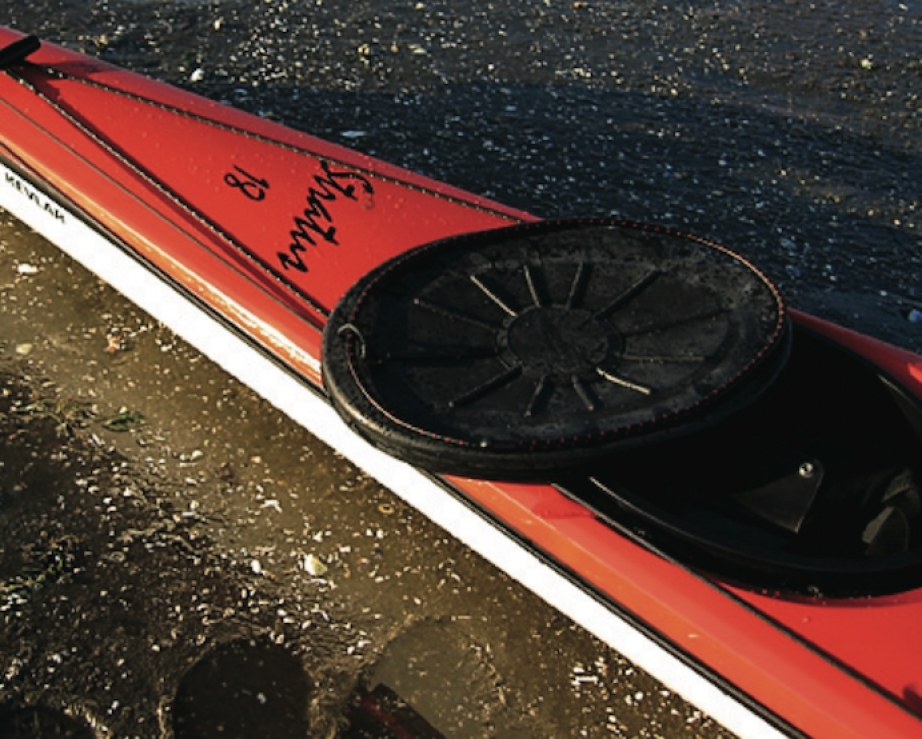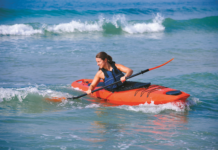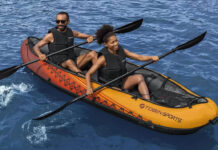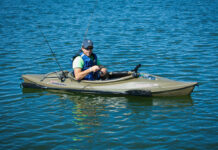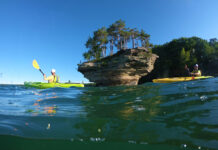Say you put on your mad-kayak-designer’s wig and lab coat and head into your workshop with your hacksaw. Then you slice the hull off a flatwater racing kayak and glue it to the deck of an expedition touring boat, complete with rubber hatch covers, deck lines, bungees, rudder and grab handles.
When the glue fumes cleared you would have something like the new Current Designs Stratus 18. This slim speedster fits into a hybrid category of boats that designer Dave Kruger calls “light performance touring.” It’s a crossbred racehorse for the paddler whose main focus is speed—racing and training—but who also wants to be able to go on multi-day tours.
Every element of the Stratus’ design reveals some concession to speed. The hull looks like a large javelin sliced down the middle. It has the smooth rounded cross section of a racing kayak or rowing shell—no v-bottomed keel or chines which would only add surface area and drag. There is virtually no rocker and the waterline extends almost all the way to the nearly plumb bow. Kruger chose a Swede-form shape (widest part of the hull behind the midpoint) for maximum glide.
The dimensions of the Stratus meet most kayak racing specifications, so it will fit into the expedition kayak category at your local adventure race and be one of the fastest hulls in the field. On calm water we were able to sustain a top speed of seven knots.
The Stratus is ideally suited to calm waters. Current Designs calls it a “quietwater” hull design because it stands in stark contrast to seagoing kayaks that have buoyant, upswept bows to ride through waves and rockered and hard-chine hulls for easy turning.
Current Designs Stratus 18 Specs
Length: 18 ft
Width: 21.75 in
Depth: 11.25 in
Weight: 50 lb glass, 46 lb Kevlar
Cockpit: 33 x 17 in
MSRP: $2,699 USD glass, $3,099 USD Kevlar
However, where flatwater racing and training kayaks typically have large, open cockpits and little or no dry storage, the Stratus is a fully decked kayak that can be paddled in rough conditions. Locked into the standard-sized touring cockpit with a sprayskirt on, we were able to easily scull, brace and roll.
The Stratus’ rounded hull cross-section results in a stability profile that is best suited for experienced paddlers. Secondary stability felt consistent and neutral through all degrees of lean; there was no obvious point where the hull resisted efforts to roll it on edge, a feature that can equal good performance in rough seas. The Stratus tracks straight due to its long waterline and minimal rocker, so the rudder comes in handy for turning and also helps prevent weathercocking in cross and quartering winds.
The Stratus 18 comes in two sizes: a standard version that would fit medium to large paddlers well, and a high-volume version suitable for extra-large paddlers or those seeking maximum capacity for long trips.
Rubber’s not just for Brits
The bow hatch is sealed by a 9.5-inch round Kajaksport rubber cover as well as a hard plastic outer cover that straps flush to the deck. The second cover also protects the rubber hatch from UV rays and spray and keeps the Stratus’ racy lines tidy. Front and rear grab handles are kept from flopping by bungees attached to the reflective decklines. Current Designs also includes a painter line for tethering this racehorse.
Sumptuous saddle
Top-quality cockpit features round out the package. A long seat base provides exceptional leg support. The Current Designs rubber-padded backband encourages an aggressive paddling stance. Aluminum foot pegs control the rudder. Instead of thigh supports extending into the cockpit opening there is thigh padding under the coaming. This cockpit design favours spaciousness and ease of entry and exit rather than a tight, controlled fit.
Introducing the superhatch
In a Swede-form hull, the widest part of the boat is behind the paddler, adding extra capacity to the stern hatch. The Stratus has an enormous 21-inch-long hatch cover to match—the largest rubber cover we’ve ever seen. We were able to drop a big duffel bag straight through the opening, and were impressed when it stayed powder dry.
This article originally appeared in Adventure Kayak‘s Fall 2005 issue. Subscribe to Paddling Magazine’s print and digital editions here, or browse the archives here.



